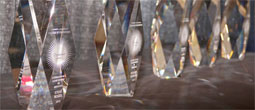Plasma Startup Creates High-energy Light to Make Smaller Microchips
By Hannah Hickey
A UW lab has been working for over a decade on fusion energy, harnessing the energy-generating mechanism of the sun. But in a twist of scientific discovery, on the way the researchers found a potential solution to a looming problem in the electronics industry.
To bring their solution to market UW engineers have launched a startup, Zplasma, which aims to produce high-energy light to etch the next generation of microchips.

“In order to get smaller feature sizes on silicon, the industry has to go to shorter wavelength light,” said Uri Shumlak, a UW professor of aeronautics and astronautics. “We’re able to produce that light with enough power that it can be used to manufacture microchips.”
For over forty years the technology industry has kept up with Moore's Law, a prediction that the number of transistors on a computer chip will double every two years, allowing ever-smaller, faster, and less energy-intensive electronics. But it's hit a roadblock: the 193-nanometer ultraviolet light now being used cannot etch circuits any smaller.
More extreme ultraviolet light comes from plasmas—high-temperature, electrically charged gases in which electrons are stripped from their nuclei. Fusion scientists, it turns out, are plasma experts. The hydrogen plasma in the sun is so hot that hydrogen nuclei fuse together and release energy. Fusion scientists around the world are working to replicate this on Earth to generate clean energy.
The UW's specialty is a lower-cost reactor that uses electrical currents, rather than giant magnets, to contain the million-degree plasma. The plasma is stable, long-lived and intense.The first time the team triggered the experiment in 1999, an engineer said, “That was really bright!“ That's when the proverbial light bulb went on and the team began to explore applications for bright, high-energy light.
The team may have found that application in the microchip industry. Techniques now being considered generate a spark that lasts just 20 to 50 nanoseconds. Zplasma's light beam lasts 20 to 50 millionths of a second, about 1,000 times longer.
A gift from the Washington Research Foundation helped the team shrink the equipment from the size of a broomstick to the size of a pin, which can produce a sharp beam. The company is seeking “smart money” from investors who can integrate the new technology with existing processes.
“I hope this gets implemented into industry and has an impact,” Shumlak said. Read more »
Nominate an Exceptional Engineer for a Diamond Award

The Diamond Awards honor outstanding alumni and friends who have made significant contributions to the field of engineering. If you know an engineer who deserves recognition, we want to hear from you! Take time to nominate an engineer to join the distinguished ranks of Diamond Award honorees. The deadline for nominations is Monday, October 15.
Progress on the Capacity Problem
 The last issue of The Trend reported on the college's capacity problem. The feature story generated great interest and feedback. Thank you for taking the time to share your concerns and thoughts.
The last issue of The Trend reported on the college's capacity problem. The feature story generated great interest and feedback. Thank you for taking the time to share your concerns and thoughts.
Since the last publication, the college has received a $3.8 million state-mandated distribution to increase admission to all engineering departments. These funds allow the college to increase enrollments by 425 students in the next few years, resulting in an additional 190 engineering degrees per year, with the majority of the distribution allocated to undergraduate admissions. At this time, half of this money has been distributed throughout the departments and the other half will be distributed based on progress.
This funding comes at a critical time and helps the college begin to address the backlog of students seeking an engineering education. Applications are up again this year and unfortunately, well-qualified students are still being turned away. The college will continue to work with UW and state leadership to find creative solutions to meet the demand for engineers.